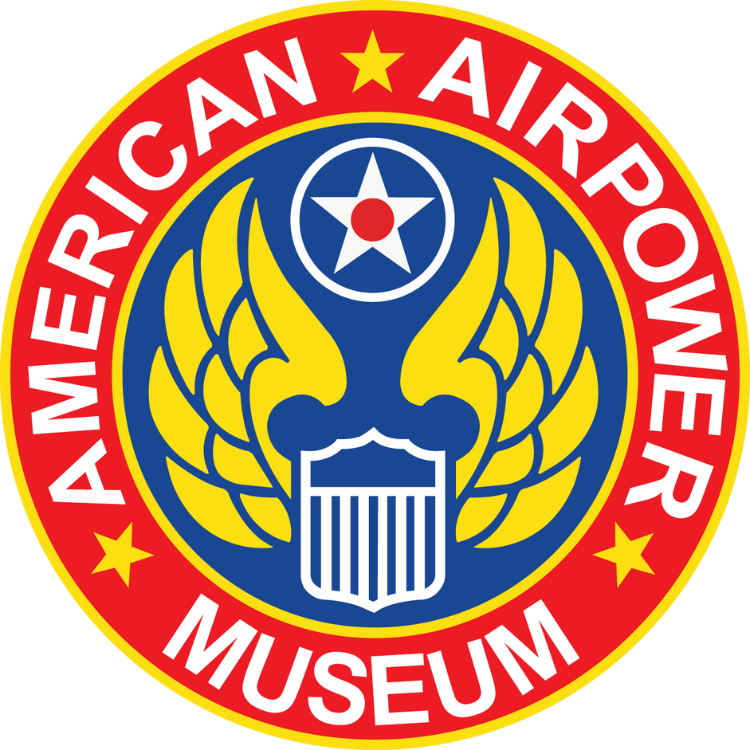WACO UPF-7
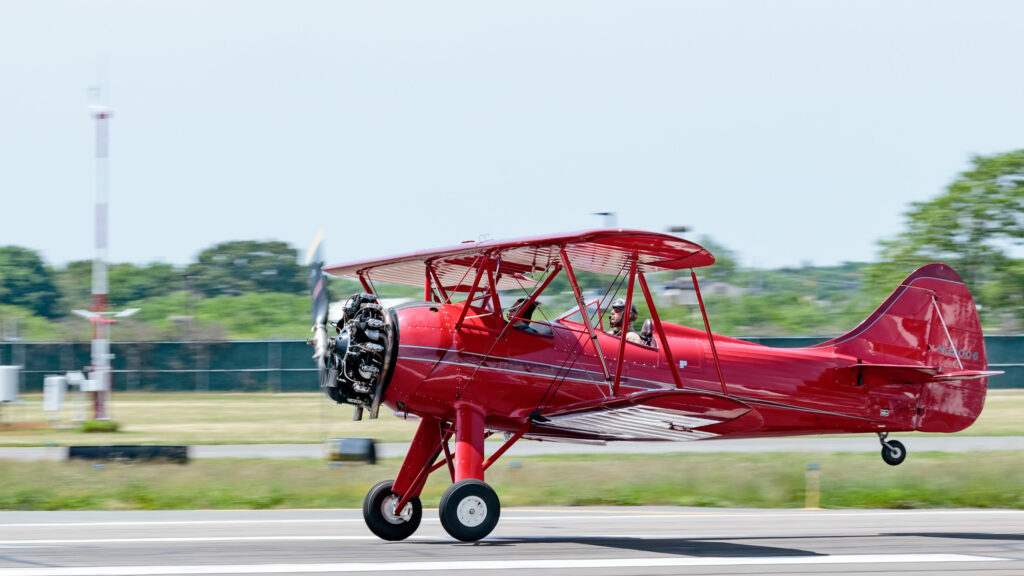
Aircraft: Waco UPF-7 Current Status: Flyable History: The Waco Aircraft Company (WACO) was an aircraft manufacturer located in Troy, Ohio, USA. Between 1919 and 1947, the company produced a wide range of civilian biplanes.The company initially started under the name Weaver Aircraft Company of Ohio but changed its name to the Waco Aircraft Company in 1928/29Waco’s history started in 1919 when businessmen Clayton J. Brukner and Elwood Junkin met barnstorming pilots Charley Meyers and George Weaver. Although their initial floatplane design was a failure, they went on to form the Waco company in 1920 and established themselves as producers of reliable, rugged planes that were popular with travelling businessmen, postal services, and explorers, especially after the company began producing closed-cabin biplane models after 1930 in addition to the open cockpit biplanes. During World War II, Waco produced large numbers of military gliders for the RAF and US Army Air Forces for airborne operations, especially during the Normandy Invasion and Operation Market Garden. The Waco CG-4 was the most numerous of their glider designs to be produced. At the same time Waco produced over 600 of its UPF-7 open biplanes and 21 VKS-7F cabin biplanes for the Civilian Pilot Training Program, which supplemented the output of the military training establishments. 42 privately-owned models of sixteen types were impressed into service as light transports and utility aircraft with the USAAF under the common designation C-72/UC-72. Production of commercial biplane trainers virtually ended in Depression years of the early 1930s, and new low-powered monoplanes rapidly took their place in the schools and in private aviation. Only the Army and Navy were principal customers for biplane trainers in succeeding years. While Waco did not have a share of this market, it was one of the few firms that continued to supply open cockpit biplanes to private owners of the mid-1930s, a group comprising what could be considered a custom trade. Yet the UPF-7, introduced in the late twilight of the biplane era, was built in greater quantity than any single Waco model that preceded it. Approximately 600 came out of the Troy, Ohio factory between 1937 and 1942. The UPF-7 was a continuation of the Waco “F” series which had been introduced with Model INF of 1930, a three-seater powered with a 100 hp Kinner K-5 engine. Other Fs in the series used a variety of engines up to 220 hp. The UPF-7 standardized on the 220 hp Continental W-670-6A, civil equivalent of Continental’s R-670 military engine. Its designation reflected the principal design characteristics of the airplane: the letter “U” identified the engine as the W-670, the “P” identified the wing and fuselage design, the “F” identified the model type or series. Details like landing gear and tail shape varied greatly through the series. While the UPF-7 was built in the largest numbers, there were limited other versions also built, mostly for special customers. These were known as LPF, VPF, YPF, and ZPF models. The only difference being the installation of different engines. Essentially a state-of-the-art refinement of the 1930 model, the UPF-7 retained its major features, particularly the heavily staggered wings with the strut-connected ailerons in upper and lower panels. The earlier Fs were all built as three-seaters, with two passengers seated side-by-side in the front cockpit. The UPF-7 was intended to be a dual-control trainer, but when the stick was removed, the front seat was wide enough to accommodate two passengers. In addition to the current nostalgic hobby activities, some UPF-7s are back in commercial operation at schools that teach aerobatics while others, thanks to two-seat front cockpits, hop paying passengers at air shows. Some are used for barnstorming in search of passengers. From the original 600, the total of Waco UPF-7s has decreased steadily. Today there are currentl about 150 in civil registery. About Our WACO UPF-7: The American Airpower Museum WACO UPF-7 is part of a private collection on loan to the museum. The WACO is currently on display, and also is one of the aircraft available for Flight Experiences at the museum through Spring, Summer, and Fall.
North American AT-6D “Texan”
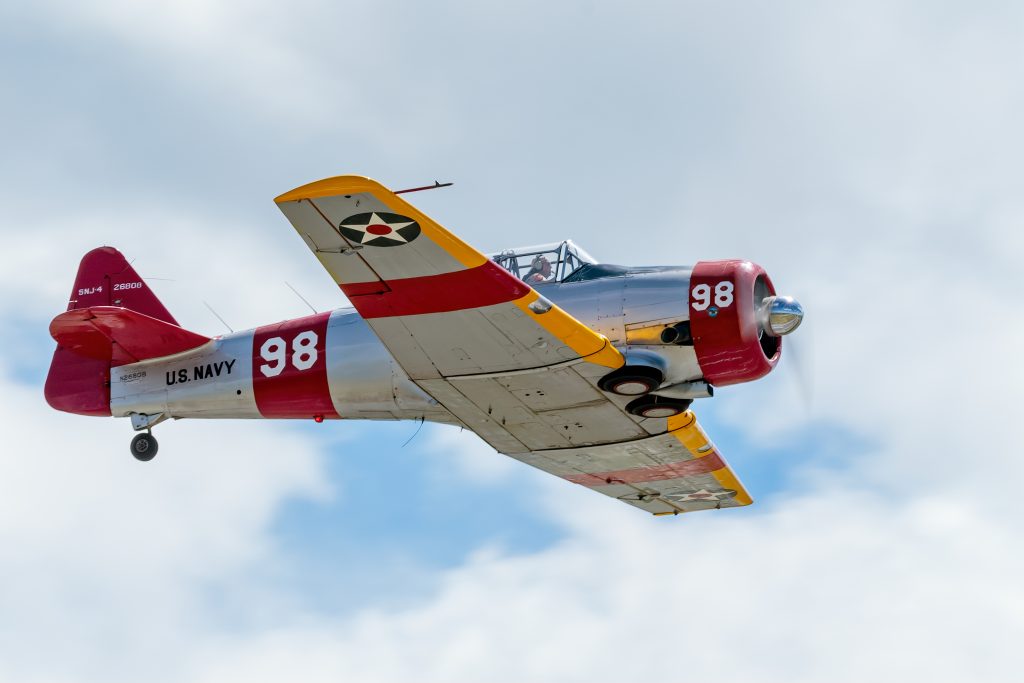
Aircraft: North American AT-6D “Texan” Current Status: Flyable History: The North American Aviation T-6 Texan was an all-metal single-engine aircraft used to train pilots of the United States Army Air Forces, United States Navy, Royal Air Force, and other air forces of the British Commonwealth from the 1930s through the 1950s. Designed by North American Aviation, the T-6 is known by a variety of designations depending on the model and operating air force. The USAAC designated it as the AT-6, the United States Navy the SNJ, and British Commonwealth air forces, the Harvard, the name it is best known by outside of the United States. The Texan originated from the North American NA-16 prototype (first flown on April 1, 1935) which, modified as the NA-26, was submitted as an entry for a USAAC “Basic Combat” aircraft competition in March, 1937. The first model went into production and 180 were supplied to the USAAC as the BC-1 and 400 to the RAF as the Harvard I. The US Navy received 16 modified aircraft, designated the SNJ-1, and a further 61 as the SNJ-2 with a different engine. A total of 15,495 T-6s of all variants were built. During the Korean War and T-6s were pressed into service as forward air control aircraft. These aircraft were designated T-6 “Mosquitos. AT-6s would serve in the French, Portuguese, and the South African Air Forces seeing its last service in the South African Air Force in 1995. About Our North American AT-6 “Texans”: The American Airpower Museum Operates 2 AT-6Ds in its squadron of flyable aircraft. The Aircraft are the primary trainer, and proficiency aircraft for all warbird flight operations at the museum. The Museum also flies the AT-6s as part of its flight experience program offering Warbird Flights to the general public.
North American P-51D “Mustang”
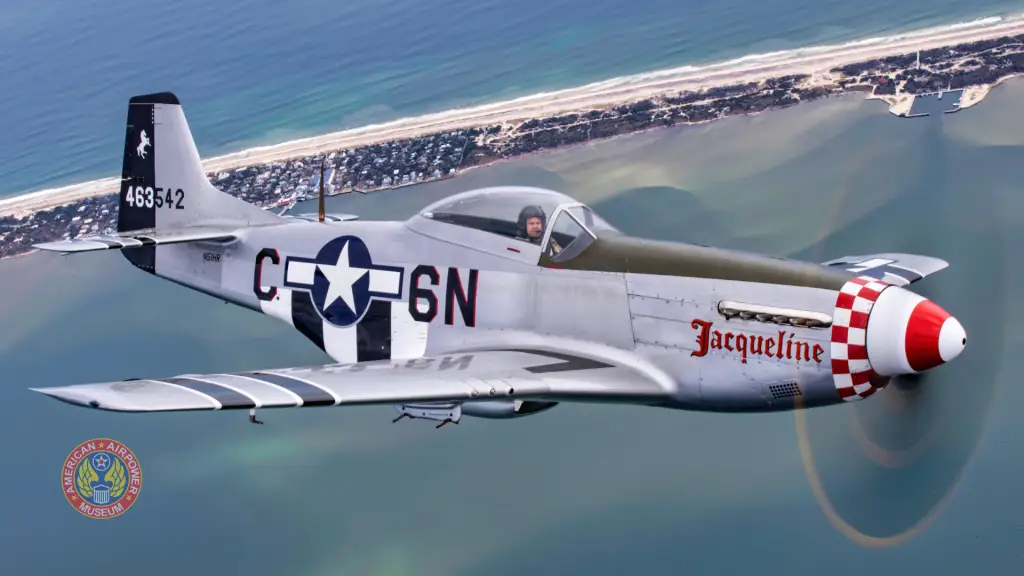
Aircraft: North American P-51D “Mustang” Current Status: Flyable History: The P-51 “Mustang” is one of the most well-known fighters of World War II. The Mustang’s impressive maneuverability and long-range capability made it one of the best bomber escort fighters of the war as well as a capable ground attack fighter-bomber. Designed in response to the British RAF lend lease request in 1940 for additional Curtiss P-40s, North American Aviation promised to design and produce something even better. The Mustang would go from concept to initial production and flight in barely 6 months, flying for the first time in October of 1940. Ironically the USAAF didn’t initially order the Mustang, but under direction of General “Hap” Arnold the USAAF would retain some of the British order and explore the use of the Mustang. This would lead to the USAAF accepting the first P-51As in 1942. Early A Models as well as the A-36 Apache attack variant would see combat in the China-Burma-India theater, and the North African Campaigns in 1943 with relative success due to the low altitude combat environment it fought in. It would be the arrival of the new P-51B/Cs in England and their debut in the air war over Europe that would highlight the newly improved variants now fitted with the Packard Merlin Engine making the new P-51s capable of the long-range high-altitude escort much needed for the strategic bombing campaign against Germany. The Mustang’s initial success against the German Luftwaffe would be followed by the introduction of the P-51D in early 1944 and the now improved Mustang, fitted with the high visibility bubble canopy, would become the USAAF’s premiere long range escort fighter. P-51 units in Europe would claim nearly 5,000 German Aircraft shot down by the end of the war. Mustangs would also serve with distinction in the strategic bombing campaign against the Japanese Home Islands escorting B-29s and attacking ground targets in Japan. The P-51s service wouldn’t end after World War II as it would go on to serve in the newly created US Air Force and be called upon once again at the outset of the Korean War in 1950. The Mustang would fill the gap from the large number still in service and stored post war. The Mustangs would prove their worth once again as they would be able to fly interdiction and Close Air Support due to their longer range, and endurance than the early Jet fighters of the time. The now designated F-51 would serve in combat in Korea until 1953 when jet fighters would eventually replace most Mustang Units. The F-51 would go on to serve in the Air National Guard and Air Force Reserve until finally retired 1957. The Last mustangs in US Military service would serve as chase aircraft for the US Army test programs in 1968. Mustangs would go on to serve in foreign air forces, the last retiring in 1984. The P-51 has been a highly sought-after Warbird and Air Racer since the post WWII years and continues to attract the attention of pilots, historians, and spectators at air shows still today. About Our North American P-51D “Mustang”: The American Airpower Museum North American P-51D Mustang acquired in 2018 was produced at the main North American Aviation plant in Inglewood, California in 1944. Accepted by the USAAF in November of 1944 our P-51 was then shipped to the Italian Theater of Operations where it was a replacement aircraft for the USAAF 15th Air Force. It remained in the replacement depot having not been assigned to a combat squadron until July of 1945 when it was returned to the Unites States through the port of Newark, NJ. It would remain in storage until 1947 when it was returned to active Air Force operational status. The Aircraft would go on to serve in both the Active-Duty Air Force, and the Air National Guard until sold surplus in 1957. Oct 1947 To 31stFighter Group (Tactical Air Command), Turner AFB GA (deployments to Smyrna AFB TN, to F-51D) Nov 1948 To 171stFighter Squadron (Air National Guard), Detroit-Wayne County AP MI Jul 1950 To 172ndFighter Squadron (ANG), Kellogg Field MI Feb 1951 To 172ndFighter-Interceptor Squadron (Air Defense Command), Kellogg Field May 1951 To 56thFighter Wing (ADC), Selfridge AFB MI (deployments to Eglin AFB FL) Jan 1952 To Middletown Air Materiel Center, Olmstead AFB PA. May 1952 To 172ndFighter-Interceptor Squadron (ADC), Selfridge AFB (deployments to O’Hare IAP IL and Oscoda AP MI). Nov 1952 To 431stFighter-Interceptor Squadron (ADC), Selfridge AFB (deployments to Griffiss AFB NY and Eglin AFB) Mar 1953 To 37thFighter-Interceptor Squadron (ADC), Ethan Allen AP VT Dec 1953 To 182ndFighter-Bomber Squadron (ANG), Brooks AFB TX Aug 1956 To 182ndFighter-Interceptor Squadron (ANG), Kelly AFB Sep 1956 To Sacramento Air Materiel Area, McClellan AFB CA Feb 1958 Dropped from inventory sold as surplus Our P-51D would go on to civilian ownership where it would eventually find a home in the personal collection of Mr. Tom Contri of Reno, NV and would remain there until 2017. Acquired by a private collection it is now on loan to the American Airpower Museum and flies regularly at the museum, and at Air Shows and events primarily in the Northeast United States.
Curtiss P-40M “Warhawk”
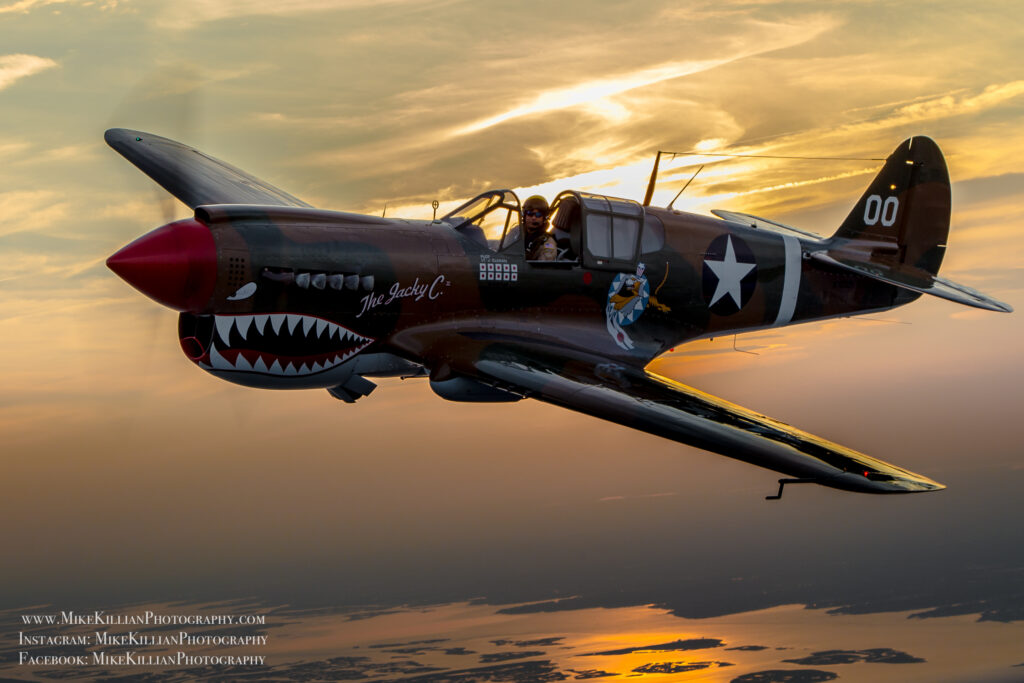
Aircraft: Curtiss P-40M Warhawk Current Status: Flyable History: The Curtiss P-40 Warhawk was a single-engine, single-seat, all-metal fighter, and ground-attack aircraft that first flew in 1938. The P-40 design was a modification of the previous Curtiss P-36 Hawk which reduced development time and enabled a rapid entry into production and operational service. The Warhawk was used by most Allied powers during World War II and remained in frontline service until the end of the war. It was the third most-produced American fighter of World War II, after the P-51 and P-47; by November 1944, when production of the P-40 ceased, 13,738 had been built, all at Curtiss-Wright Corporation‘s main production facilities at Buffalo, New York. About Our Curtiss P-40M: The American Airpower Museum Curtiss P-40M Warhawk, known at the museum as the “Jacky C” was manufactured at the Curtiss Buffalo, NY plant in 1943. Delivered that same year to the Royal Canadian Air Force Western Air Command as Serial Number AK845. AK845 served in defense of Canada’s west coast, eventually being utilized as a training aircraft for operational training unit No.5. It would eventually be sold as surplus in 1946. It was registered in the US Registry as N1232N and brought to the west coast where it was flown by the Weather Modification Company from the late 1950’s until 1961. It would eventually find its way to the famed Harrah’s Automobile & Aircraft Collection. It would be acquired in 1982 by Warbird and Reno Air Race pilot and restorer Bill Destafani who would restore it to flying condition in 1983. It would join the Lonestar Flight Museum Collection from 1991-1997 until acquired by our museum’s founder in 1997. It would be one of the first aircraft loaned to our museum’s collection in 2000 and has been on display and a regular performer at Air Shows on the east coast for over 20 years. Photo Courtesy of Mike Killian and ©American Airpower Museum. Download or re-publishing requires the permission of the American Airpower Museum.
North American B-25 “Mitchell”
Aircraft: North American B-25 “Mitchell” Current Status: Flyable History: The North American B-25 Mitchell is an American medium bomber that was introduced in 1941 and named in honor of Major General William “Billy” Mitchell, a pioneer of U.S. military aviation. Flown by many Allied air forces, the B-25 served in every theater of World War II, and after the war ended, many remained in service, operating across four decades. Produced in numerous variants, nearly 10,000 B-25s were built. These included several variants including the USN, and USMC PBJ-1 patrol bomber. The B-25 became etched in the public lexicon as the bomber used in the 18 April 1942 Doolittle Raid, in which 16 B-25Bs led by Lieutenant Colonel Jimmy Doolittle attacked mainland Japan after launching from the deck of the USS Hornet 600 miles off the coast of Japan. The attack came four months after the bombing of Pearl Harbor and would be the first blow to the Japanese Empire to avenge the attack on Pearl Harbor on December 7th, 1941. The heroic mission would be a welcome morale boost to the American public during the early days of WWII where US combat success had been limited. It was also a blow to the Japanese psyche, as the Japanese had believed their home islands to be out of reach by enemy forces. About Our North American B-25 “Mitchell”: The American Airpower Museum North American B-25 Mitchell “Miss Hap” is the oldest example of the B-25 still in existence. Built in 1940-41 at the North American Aviation plant in Inglewood, CA, now adjacent to where LAX stands today, it was part of the first 24 built for the US Army Air Corps as part of President Roosevelts pre-war build up. One of the first B-25s delivered to the USAAC in February of 1941 at Mchord Field in Washington State, it was assigned to the 17th Bomb Group, 34th Bomb Squadron. It flew with the 17th BG through 1942 and participated in the famed pre-war exercise known as the Louisiana Maneuvers. It would go on to serve as an administrative and training aircraft until 1943 when it was return to the North American Factory in California where it along with its sister ship serial number 40-2165 it was converted into a VIP transport. Our tail 40-2168 would be presented to the USAAF for use as the personal transport for General Henry “Hap” Arnold, Commander of the USAAF during WWII. It would be stationed at Bolling Field from 1943-1944 during this time. After being replaced by a newer B-25J in late 1944 40-2168 would serve at different bases up and down the east coast in an administrative role ultimately being retired from service at the end of WWII. Purchased surplus is was owned by Howard Hughes in the 1950s, various civilian owners through the 1980s until purchased by Jeff Clyman, founder of the well-known flight jacket company Avirex Ltd, and Cockpit USA in 1989. It has since been donated to the American Airpower Museum by Mr.Clyman and has been flying in air shows throughout the country now for over 30 years.
Grumman TBM-3E “Avenger”
Aircraft: Grumman TBM-3E “Avenger” Current Status: Flyable History: The Grumman TBM-3E “Avenger” is the late World War Two variant of the original Grumman TBF Torpedo bomber first flown in 1941. The TBM-3E production began in 1944 and was manufactured by the Eastern Aircraft Division of General Motors in Ewing, NJ now the Trenton Mercer Airport. The “TBM” designation was assigned to all versions produced by Eastern Aircraft Division of General Motors that began in 1943 with the TBM-1. The TBF/TBM was initially developed as a torpedo bomber for the US Navy, and US Marines and would eventually serve in the air and naval services of allied nations during and after WWII. The TBM would go through numerous conversions after the war and would see service in the US Navy through the 1950s. The TBF/TBM would first enter service with the US Navy in 1942 and flew in combat for the first time as a land-based Torpedo Bomber during the Battle of Midway in June of 1942. Although its combat debut was less than stellar, taking heavy losses, it would go on to serve with distinction as the workhorse of carrier-based fighter bomber operations during the Battle of Guadalcanal, the island-hopping campaign through the pacific, the battle for Okinawa, and culminating in the attacks on the Japanese Home Islands until the Japanese surrender in August 1945. The “Avenger” was notably flown by former President George H.W. Bush off the USS San Jacinto. During an attack on the Island of Chichi Jima in September 1944 he was shot down and rescued by the submarine USS Finback. He would receive the Distinguished Flying Cross for his actions. Famed actor Paul Newman also served as a rear gunner in the “Avenger” flying from the USS Hollandia in 1945 through the Japanese Surrender. About Our TBM-3E “Avenger”: The American Airpower Museum Grumman TBM-3E “Avenger” Bu. #85886 is currently part of a private collection, currently on loan to the museum for display and operation. Our “Avenger” was manufactured in Trenton, NJ in 1945, entering service with the US Navy. It would go on to be assigned to VA-1L also known at VT-58 in 1946 and would eventually be stationed at NAS Atlantic City NJ and serve abord the USS Saipan with the US Navy Operational Development Force along with TBM-3Ws, F6F Hellcats, and SB2C Helldivers. Although the exact date of its surplus is not known the aircraft would be transferred to the civilian registry in 1963 with the N#9586Z that it still carries today. Our “Avenger” would go on to fly as a crop sprayer and water tanker until it was restored to its WWII military configuration in 1983. It began its Warbird life in the mid-1980s and began appearing at Air Shows in the US. It would be acquired in 1989 by its present owner and continued flying in air shows on the east coast. It would be one of the first warbirds to join the American Airpower Museum Collection of Aircraft at our founding in 2000. It has been a mainstay in the Northeast Air Show circuit, and on display at the Museum for the last 30 years.
Douglas C-47B “Skytrain”

Aircraft: Douglas C-47B “Skytrain” Current Status: Flyable History: The Douglas C-47 “Skytrain” or “Dakota” is a military transport aircraft developed from the famed Douglas DC-3 Airliner. Operated by the USAAF and allied air forces during WWII it would go on to serve with distinction long after the war throughout the world and is still in service today. More than 10,000 aircraft were produced in Long Beach and Santa Monica, California as well as Oklahoma City, OK. Between March 1943 and August 1945, the Oklahoma City plant produced 5,354 C-47s. The C-47 was credited as vital to the success some of the major campaigns of WWII. Supporting the battle in the Pacific in its early days, flying the “Hump” critical to the resupply of operations in China, Burma, and Southeast Asia. Earning its most notable fame as the carrier of Paratroopers of the 101st and 82nd Airborne as well as Glider Infantry during Operation Overlord better known as D-Day the Invasion of Normandy France – June 5/6, 1944. Also used with great success in Operation Market Garden the combined airborne and armored attack on Holland in September 1944, and re-supplying troops under siege during the Battle of the Bulge in December 1944-January 1945. Of note, 2,000 C-47s in British and Commonwealth service took the name Dakota possibly inspired by the acronym “DACoTA” for Douglas Aircraft Company Transport Aircraft. The C-47 also earned the informal nickname “Gooney Bird” in the European theatre of operations. Other sources attribute this name to the first aircraft, a USMC R2D—the military version of the DC-2—being the first aircraft to land on Midway Island, previously home to the long-winged albatross known as the gooney bird which was native to Midway. About our Douglas C-47B “Skytrain”: The American Airpower Museum Douglas C-47B “Skytrain”, affectionately known as “Second Chance” is a unique original un-modified C-47B built in 1944 and supplied to the USAAF and flown to England where it was transferred to the British Royal Air Force in 1945. Serving through the end of WWII and the Berlin Airlift our C-47 would go on to serve in the French Air Force during the Indo-China conflict in Vietnam and would eventually spend most of its operational life in the service of the Israeli Air Force. The C-47 would end its military service in 1996 and was sold surplus into the general aviation community. The C-47 was flown to Canada and then the United States where it was acquired in 2000 by the American Airpower Museum. The C-47 dubbed “Second Chance” began flying from our museum at Republic Airport almost immediately after it was acquired and was painted to resemble the C-47s that flew on D-Day June 5/6th, 1944. “Second Chance” carries the unit colors of the 439th TCG of IX Air Force Troop Carrier Command whose C-47s carried paratroopers of the 101st Airborne Division from Upottery England to their drop Zones in and around St. Mere Eglise in Normandy, France. Our C-47 is unique in the Warbird community as it has maintained its stock military Configuration throughout its operational life, making it one of the most original stock aircraft still flying today. The American Airpower Museum C-47 has been and is a popular attraction at Air Shows up and down the East Coast of the United States for over 20 years and flies regularly at the museum during the Spring, Summer, and Fall Months. In addition, our C-47 is the highlight of our unique D-Day Living History Flight Experience where customers can purchase seats to fly back in time aboard this historic aircraft. Flight Experience Rides are available Spring – Fall at the museum. See our Flight Experiences Page for more info.
North American AT-28D-5 “Nomad”
Aircraft: North American AT-28D-5 “Nomad” MK 1 Current Status: Flyable History: The North American Aviation T-28 Trojan was originally built as a tandem seat radial-engine military training aircraft for the United States Air Force and United States Navy beginning in the 1950s. The Air Force phased out the first variant built as the T-28A from primary pilot training by the early 1960s, continuing its use only for limited training of special operations aircrews and for primary training of select foreign military personnel. The much improved model T-28B/C continued to be used as a primary trainer by the US Navy, Marines, and Coast Guard well into the early 1980s finally being retired in 1984. In the early 1960s the T-28 was identified as combat capable platform, as a result T-28A, B, and Cs were converted throughout the decade by both North American Aviation and sub-contractors into a counter-insurgency attack aircraft. AT-28Ds were supplied to the Republic of Vietnam and Laotian Air Forces beginning in the early 1960s. The bulk of AT-28s in the Southeast Asia theater of operations during he Vietnam War were flown by the USAF “Ravens” also known as Air Commandos into the early 1970s. These were the early units of what would become U.S. Air Force Special Operations Command. The AT-28s were also used in clandestine operations by Air America the covert air arm of the CIA during the Vietnam War. About Our North American AT-28D-5 “Nomad” MK 1: Our AT-28D-5 was manufactured by North American Aviation, Inglewood California as a T-28A “Trojan” trainer and delivered to the USAF on 2 May 1950. Being one of the first of its type is went on to the 2759thExperimental Wing (Air Materiel Command), Edwards AFB CA in the same month. It would go on to be modified into an ET-28A at the 2750thAir Base Wing (AMC), Wright-Patterson AFB OH in August of 1950. It would serve as a test aircraft for the HQ Air Research and Development Command, Wright-Patterson AFB until June of 1951 when it returned to Edwards AFB and the 2759th Experimental Wing. It remained at Edwards AFB assigned to the 6510thAir Base Wing, 6512thTest Pilot Training Squadron, and the AF Flight Test Center until May of 1962. It briefly was assigned to the 3550thMaintenance and Supply Group (Air Training Command), Moody AFB GA until finally retired in September of 1962 and placed in storage at Davis Monthan AFB, AZ. In June of 1965 it was pulled out of mothball and sent to the North American Aviation Plant in Columbus, OH where it joined other A-Models pulled from storage for conversion into the counter-insurgency light attack variant requested by the USAF for use in the burgeoning conflict in Southeast Asia and designated the AT-28D-5. Built to the NAA NA-260 specifications with its additional combat upgrades it would pick up the nickname of the NOMAD. Upon completion of its overhaul from an A-model to the D-Model it was sent to Sacramento Air Logistics Area, McClellan AFB CA in July of 1966, where it was transferred to the growing Military Assistance Program in Southeast Asia. Delivered to Thailand between 1966 and 1967 as part of MAP aid to Laos it was transferred and operated by the USAF “Raven” Program in combat operations from 1968-1970 operating out of Udorn Air Base in Thailand where it was maintained by Air America although operated under the guidance of the USAF Air Attache’ in Laos. Eventually operated by Air America pilots 49-1496 operated out of Thailand, Laos, and Vietnam until 1973 when it was transferred to the Laotian Air Force. Our North American AT-28D-5 is still in its stock military configuration as it was during the Vietnam war. The aircraft pays tribute to all those who served during the Vietnam War, specifically honoring the brave USAF Special Operations Squadrons and pilots known as “Ravens”, and the CIA’s Air America airmen who operated in the “secret war” in Laos, and Cambodia. The American Airpower Museum North American AT-28D-5 USAF serial number 49-1496 is currently part of a private aircraft collection, and is graciously on loan to the museum for display and operation. The AT-28D-5 flies regularly at the museum, and to air shows up and down the east coast.
Aero Vodochody L-39ZA “Albatros”
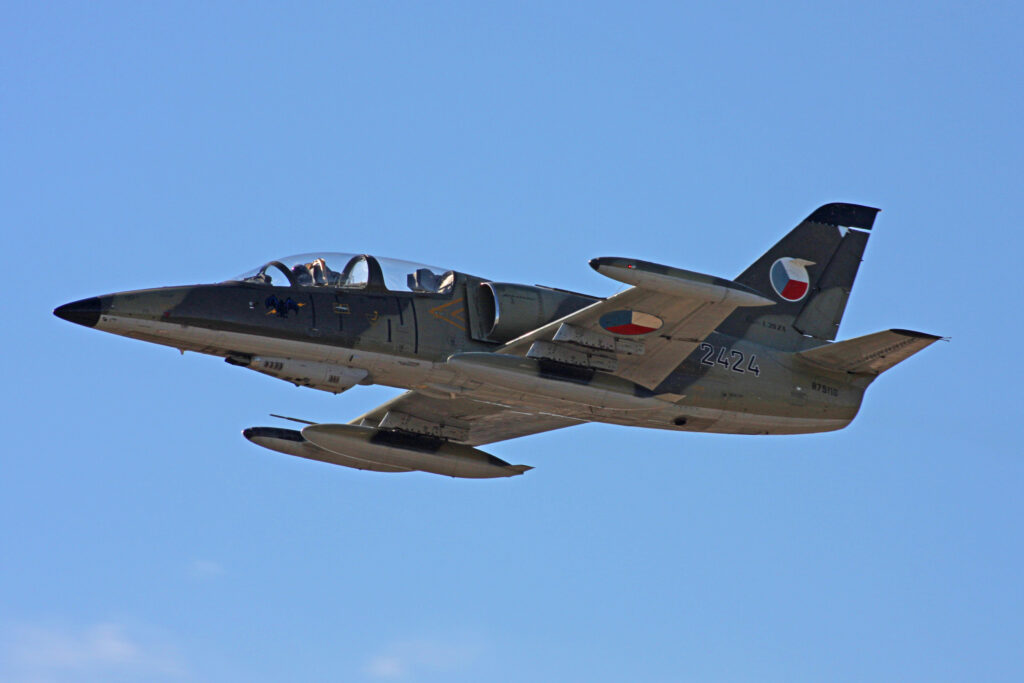
Aero Vodochody L-39 Albatros Current Status: Flyable History: The Aero L-39 Albatros is a high-performance jet trainer aircraft developed in Czechoslovakia to meet requirements for a “C-39” (C for cvičný – trainer) during the 1960s to replace the L-29 Delfín. It was the first of the second-generation jet trainers, and the first turbofan-powered trainer produced. The design is still produced in an evolved state as the L-159 ALCA. The Albatros – the most widely used jet trainer in the world with more than 2,800 having served with over 30 air forces around the world in light-attack missions as well as in basic and advanced jet pilot training. The L-39 (under the name Prototype X-02) first flew on 4 November 1969 and was piloted by Rudolf Duchoň, the factory’s test pilot. Serial production began in 1971. The basic trainer is not armed but has two under wing pylons for drop tanks and practice weapons. Light-attack variants have four under wing hard points for ground attack stores; the ZA also has an under-fuselage gun pod. The L-39 is no longer in production and is replaced by the L-159. While newer versions are now replacing older L-39s in service, thousands remain in active service as trainers, and many are finding new homes with private owners all over the world. This is particularly evident in the United States, where their $200,000-$300,000 price puts them in range of moderately wealthy pilots looking for a fast, agile personal jet. Their popularity led to a purely L-39 Jet class at the Reno Air Races, though it has since been expanded to include other, similar aircraft. About Our Aero Vodochody L-39 Albatros: The American Airpower Museum currently maintains 3 L-39s in its collection. The Museum flies 2 L-39Cs, and a L-39ZA the armed combat variant of the Albatros. The L-39s fly local demos, and in air shows during the Spring and Summer season. They are part of the Cold War Collection on display at the American Airpower Museum.
Aero Vodochody L-39C Albatros

Aircraft: Aero Vodochody L-39 Albatros Current Status: Flyable History: The Aero L-39 Albatros is a high-performance jet trainer aircraft developed in Czechoslovakia to meet requirements for a “C-39” (C for cvičný – trainer) during the 1960s to replace the L-29 Delfín. It was the first of the second-generation jet trainers, and the first turbofan-powered trainer produced. The design is still produced in an evolved state as the L-159 ALCA. The Albatros – the most widely used jet trainer in the world with more than 2,800 having served with over 30 air forces around the world in light-attack missions as well as in basic and advanced jet pilot training. The L-39 (under the name Prototype X-02) first flew on 4 November 1969 and was piloted by Rudolf Duchoň, the factory’s test pilot. Serial production began in 1971. The basic trainer is not armed but has two under wing pylons for drop tanks and practice weapons. Light-attack variants have four under wing hard points for ground attack stores; the ZA also has an under-fuselage gun pod. The L-39 is no longer in production and is replaced by the L-159. While newer versions are now replacing older L-39s in service, thousands remain in active service as trainers, and many are finding new homes with private owners all over the world. This is particularly evident in the United States, where their $200,000-$300,000 price puts them in range of moderately wealthy pilots looking for a fast, agile personal jet. Their popularity led to a purely L-39 Jet class at the Reno Air Races, though it has since been expanded to include other, similar aircraft. About Our Aero Vodochody L-39 Albatros: The American Airpower Museum currently maintains 3 L-39s in its collection. The Museum flies 2 L-39Cs, and a L-39ZA the armed combat variant of the Albatros. The L-39s fly local demos, and in air shows during the Spring and Summer season. They are part of the Cold War Collection on display at the American Airpower Museum.
